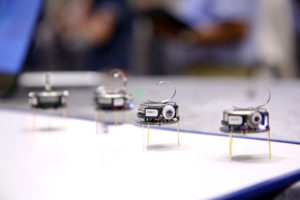Robot whisperer

Harvard-developed Kilobots are half-dollar sized robots that can make simple measurements in their environment and communicate with their nearest neighbors using infrared signals. (Photo: Krell Institute.)
Julia Ebert creates, builds and learns. But her varied interests – in neuroscience, coding, baking, ice-rink sports, web design and robotics – make her hard to pin down, even for those who know her best. “I had no idea what you were going to do,” Ebert’s father once told her. “You were interested in everything.”
It’s no wonder then that Ebert merged a behavioral neuroscience major with computer programming at Northeastern University in Boston. Now the Department of Energy Computational Science Graduate Fellowship (DOE CSGF) recipient is combining coding and biology again, developing swarms of small robots that collaborate to perform tasks. Someday similar groups may do jobs that bore or endanger humans.
Ebert is part of Radhika Nagpal’s Harvard University lab, where researchers take lessons from biology, such as termites building collectively or bacteria cooperating, to make groups of robots that work well together.
So far Ebert has focused on collective decision making using Harvard-developed Kilobots, half-dollar-sized robots with limited intelligence, sensing and communication capacities that are deployed in groups of up to a thousand.
Ebert initially examined how 100 Kilobots used environmental cues to make collective decisions. She based her experiments on the house-hunting problem – strategies that groups of bees and ants use as they search for a new home.
Ebert starts by using computers to simulate test runs of her experiments, letting her identify potential pitfalls and try out scenarios before setting up longer trials with the Kilobots. She has shown that the miniature robots can use simple sensing and communication to detect colors and make decisions about environmental features.
Someday robot swarms could handle a range of dirty, dull and dangerous tasks, such as setting up a habitat for humans on Mars, she says. But in that scenario, the devices must deal with complex situations in which one set of decisions leads to others. On Mars, for example, robots might have to spread out to locate an area with enough water for humans. “So one piece of this bigger puzzle that we’re trying to sort out is how you get more complex behavior out of groups of robots,” she says.
Besides herding a robot gaggle, Ebert explores a range of algorithmic approaches for solving problems. She wants to find general strategies that groups of devices could use in many scenarios, not just in a single situation. “Swarm robotics is at a very early stage. There aren’t unifying theories about how to approach and how to solve problems when they’re spread out over this many robots.”
In fall 2017, Ebert designed and built her own devices, nicknamed LARVAbots. The machines mimic insects crawling over each other to see whether the group can stay together and move faster than an individual. Ebert completed the initial design in a single semester, producing six brightly-colored, hand-sized treaded robots. In experiments, the machines coordinated their actions and even enabled one of them to escape from a walled track.
Ebert is fearless, Nagpal says. “She has a raw talent at learning, and she crosses learning curves at speeds that are a little intimidating to the rest of us.”
In an early course at Northeastern, Ebert learned to code in MATLAB, the ubiquitous scientific computing language. “It turns out I was pretty good at it, and I really enjoyed it,” she says. By her second year she had combined her biological and computational interests in Dagmar Sternad’s laboratory, picking apart how people learn motor tasks based on feedback cues and eventually programming robots for human experiments.
In 2015 Ebert earned a Marshall Scholarship and headed to Imperial College London, where she studied human-robot interactions and earned a master’s degree in bioengineering. Working with researchers Etienne Burdet and Ildar Farkhatdinov, Ebert helped devise the human-robot interface for the lower-limb powered exoskeleton (LOPES), a wearable robot designed to help injury or stroke victims maintain or recover their balance.
For her doctoral work, Ebert “wanted to flip it around a bit and look at the other side of how we could use biology to make better robotics.” Ebert also has turned her swarm robotics skills toward space. During her summer 2018 Lawrence Livermore National Laboratory practicum for the DOE CSGF, she worked with physicist Michael Schneider to develop software enabling small satellites to communicate and make collective decisions about their observations. She started early by coding software for the satellite simulator as a course project before arriving at the lab.
She’s still collaborating with Schneider and considering new extraterrestrial directions for her graduate research, including working with the Space Exploration Initiative at the MIT Media Lab. Ebert hopes to finish her Ph.D. by 2021 and stay in academia.
Schneider was impressed with Ebert’s independence, creativity and knowledge. “She took off running very quickly,” he says, and produced useful programming. “Even understanding what the code was doing was a challenge, but she built some pretty impressive visualization tools so we could just show it.”
This article is an excerpt from a profile in the 2019 print version of DEIXIS magazine.
About the Author
Sarah Webb is science communications manager at the Krell Institute. She’s managing editor of DEIXIS: The DOE CSGF Annual and producer-host of the podcast Science in Parallel. She holds a Ph.D. in chemistry, a bachelor’s degree in German and completed a Fulbright fellowship doing organic chemistry research in Germany.




